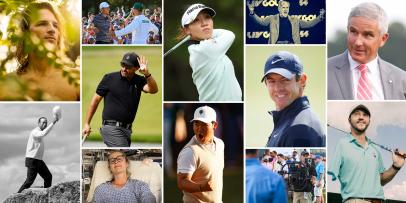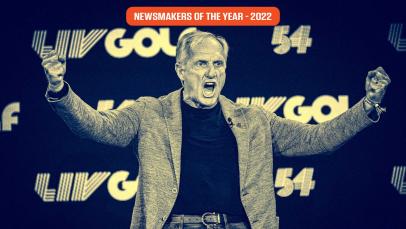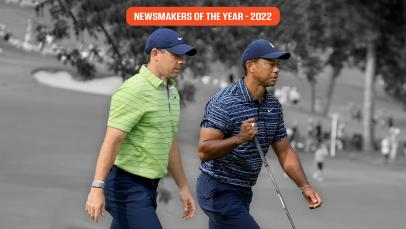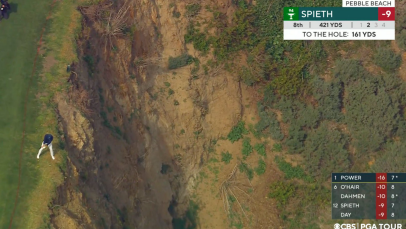Most of the time I’m at a professional event, I’m on the driving range. Some people find it boring. For a golf nerd, however, there’s simply no better place to be. During tournament weeks it’s like a hive of activity, players, coaches, trainers, fans, media, all buzzing around wondering what race car is going to fly out of the gates the fastest.
My notebook fills up pretty quickly, and most of those notes end up on the internet in some form. But the end of the year presents a good opportunity to take a step back and consider the larger picture. What were the things that truly stick with me, over the course of the year? And what can the rest of us golfers learn from them?
1. In golf, more distance is more control
I was on the ground during a practice round at the LPGA's Cognizant Founders Cup in New Jersey. Upper Montclair Country Club is one of those classic northeastern golf courses, tight and tricky. On one of those narrow holes, I watched Lexi Thompson pull a driver and slam one right of the fairway into some rough near some trees. She pulled another ball and did the same thing. I walked away with the distinct impression that this wasn’t the kind of course that would suit Thompson's game. By Sunday, she had shot 17 under and finished in solo second place.
I say this because it’s easy for the rest of us to talk ourselves out of the idea that we need to hit the ball longer. What we really need is more consistency, we say, or not to sacrifice control. I fell into that trap watching Lexi that day, forgetting the essential truth that in golf, power is control and consistency. When you hit the ball longer, you can tell the course how you want to play it—and not have to let the course tell you. This is true from the pros all the way down to the amateur ranks.
Although the early iteration of this idea lended itself to lots of bombing-and-gouging (see: DeChambeau, Bryson), as pros have gotten smarter, they’re each adding speed to their game as a kind of means to an end.
Three of this year’s major winners—Matt Fitzpatrick, Cameron Smith and Justin Thomas—are perhaps the best example of this. They’ve each actively chased distance in recent years, and it helps each of them do different things well. For Fitzpatrick, it compliments his accuracy from tee-to-green. For Smith, more power off the tee means he can put himself in a position to cash in on his short game more. For JT, more horsepower means he can be more creative with the kinds of shots he’s can hit. Rather than changing how they play, pros are adding speed nowadays because it helps them do what they do, but better.
2. Mobility is key
One of the more eye-rolly Golf Twitter debates in recent years revolves around the notion of “bulking up” and specifically why it’s a terrible thing for golfers to do. Putting aside that there are plenty of counter examples to this, the reason I find this debate so annoying is because it’s not really what pros actually care about. And even the ones that do want to add muscle mass do so extremely slowly and carefully. They know their career is singularly dependent on staying healthy. They’re not stupid.
Talk to pros about what their gym routine looks like, and it starts with injury prevention, with a specific focus on mobility work. Getting better at pushing, pulling, squatting, standing, turning.
“Those are the pillars of human movements," Kolby Tullier, who trains Justin Thomas, Dustin Johnson, Brooks Koepka, Max Homa, Jessica Korda and Lexi Thompson, told me. "From a specific standpoint, if I train you in those arenas, then you're going to become a better human, and that's going to make you a better athlete."
Working on your mobility doesn’t look like traditional weightlifting. In practice, it looks more like pilates. Lots of work with bands and body weight. Far from criticizing players for their gym routines, the rest of us should take note.
3. They love using putting mirrors
Earlier this year, my putting was in a dark place. So in an act of desperation I asked my friend Greg Chalmers, a PGA Tour winner and one of the best putters of his generation, for help. I sent him a few videos of my putting stroke, and he spotted the error almost instantly: I was standing with my eyes too far over the golf ball, which led to a cascade of compensations that, in a nutshell, was causing me to hit putts on the toe with a closed clubface.

Chalmers' advice was simple: Start using a putting mirror and an obstacle that would force you not to hit putts on a toe.
Hearing this, I couldn’t quite believe how stupid I’d been. If I had dedicated just a fraction of the energy I had spent thrashing around, switching putters and complaining, I wouldn’t have needed to spend time fixing anything.
The more I looked around on tour, the more I started to see putting mirrors everywhere. They’re littered all over tour practice putting greens, and to a man, every player uses them. They don’t all care about getting their eyes directly over the ball, and they’re not spending a bunch of time on them either. But the mirror essentially allows pros to check to make sure they’re setting up the same way, every time. To pros, using a putting mirror is like eating your vegetables. They keep your putting stroke healthy and strong.
Anyway, all of which is to say don’t worry, my putting is in a much better place than where it started, thank you for asking.
4. Mesh your swing to your body
Jon Rahm and Patton Kizzire are both world-class athletes plying their trade at the highest levels of professional sports. They’re also fantastic examples of melding a swing to their unique body. Rahm was born with a club right foot, which severely inhibited his flexibility. That’s why his backswing is so short; if he tried to lengthen it, his coach Dave Phillips said he’d probably injure himself.
Patton, for his part, stands a strapping 6'4". But because humans aren’t built in a lab to specific specifications, his legs are uniquely longer proportionately than his arms, which requires some specific tailoring of his golf swing.
“Because he’s got such long legs, he needs to create more bends in his body to get back down to the ball,” Justin Parsons, Patton's coach, says. “He feels like he sits a little bit more at address, with a little more knee flex, and his hands are higher. With any athlete, it’s about creating a dynamic posture that suits them the best.”
He concluded: “He’d probably love to swing like Ben Hogan, but that’s just not how he’s built.”
This one stuck with me. A swing like Hogan’s, or Nelly Korda’s, is obviously the envy of golfers everywhere. But in many ways, we can learn more from a swing like Rahm’s or Kizzire’s. We’ve all got unique physical traits. There is no perfect swing for all; the task is finding the perfect swing for you.
5. Pros get insecure about stuff, too
It doesn’t happen often, but every now and again, I accidentally poke at a sore spot for players. I ask them about what I thought was some innocuous thing about their game, only to get some unexpected defensive response. Cameron Tringale won the ‘oops, sorry’ lottery this year. At Bay Hill last March, I spotted him on the putting green using an open hand grip, with his palms opposing each other. When I watched him doing it he stopped what he was doing and waited for me to leave. When I asked him about it, from a place of genuine curiosity and interest, he told me he didn’t want to talk about it, and that was it.

Ben Jared
I would’ve loved to know what he was actually doing, and why, but I still walked away from that frosty interaction having learned something: Sometimes pros get insecure about their own games, too. Ultimately, they’re human, just like the rest of us. And even for a guy like Tringale, who earned more than $17 million on the PGA Tour. He never captured that elusive victory, though. Maybe his fortunes will fare better on LIV, where he jumped later that year.
6. Find your feel on the range
Sometimes conversations with pros lead you into unexpected places. Talking to Jessica Korda earlier this year, I quizzed her on warming up. Korda said that when she’s warming up, she doesn’t focus on anything other than hitting the center of the clubface. No target picking, no routine, just a singular focus on feeling her way to the center of the clubface. If she can do that, she says it gives her a better understanding of her golf swing, her tempo and her misses. Jess said she starts small—with chip shots—and slowly works her way up. I hadn’t heard of any other pros warming up like this, and I’m still not sure why.
7. Takeaway checks are the new waggle
Sam Burns established himself as one of golf’s brightest young talents in 2022. Before every golf swing, whether on the range or on the courses, he checks to make sure his takeaway is in the perfect spot. Justin Thomas does the same. So does Xander Schauffle. It makes sense, after all. They want to make the club waggle to relieve tension, but they also want to make sure their backswings start in their intended direction. Pros in many ways are masters at finding the simplest possible solution to a given problem. A two-in-one solution like this is a prime example of it.
8. Swings shorten on course (so take an extra moment)
The idea of your swing "getting too quick" is one of the more boring clichés in the book, but thanks to Hall of Famer Vijay Singh, it turns out to be true. A company called deWiz found that all golfers' backswings get shorter and quicker on the golf course than on the driving range. But thanks to an experiment by Singh, where he wore the device on the golf course, they found that pros’ swings change less. They still get slightly shorter and faster, but only slightly.
The whole thing gave me a new appreciation for the subtle pause each pro has in transition. Some, like Cameron Young, pause longer than others, but look closely enough and they all do. The tiniest moment to finish their backswing in their entirety, before transitioning and sending the club into the downswing.
9. Transfer your confidence from club to club
Earlier this year, Jim Furyk gave a lesson to my friend and former Golf.com colleague Darren Riehl. Darren was struggling with his long irons. Furyk asked him if what his favorite club was. Darren told him it was a short iron. So Furyk had him hit a handful of short irons, then one shot with his long irons, then a handful more with his short irons.
“Gradually you’ll trick yourself into feeling just as comfortable with your long irons as your short irons,” Furyk explains.
Lo and behold, it worked. Darren’s confidence with one club transferred to another. It was exactly the kind of no-frills trademark solution you’d expect from Furyk. He knows exactly what works, because he’s been there before and figured it out himself with his own two hands.
10. The shoes you're wearing really matter
I didn’t think when Tiger Woods showed up at Augusta National that he would be scooped by his own shoes, but he was. No more Nikes. He debuted a new pair of FootJoys and has been wearing them for every round since. This was more than a fashion statement.
So many modern, sneaker-style shoes tend to give you extra padding under your heel, which is comfy, but also tends to pitch your heel up slightly. That’s good for some golfers, but not everyone, and not Tiger. For the 15-time major champ, a flatter-to-the-ground model offered him more mobility. A good reminder for the rest of us that the type of shoes your wearing can be just as important as the kind of golf ball you’re hitting, or clubs you’re swinging.
11. Straight looks different to everyone
It wasn’t until the U.S. Open I realized something quite interesting about Scottie Scheffler’s putting stroke: That the 2022 Masters champ stands really closed, with his feet, to the line of his putt. The reason for this is simple: Everybody’s eyes are subtly different, so being able to see in a straight line, from your putting posture, requires different adjustments for everyone. Jack Nicklaus needed to stand with his feet open to see a straight line. Justin Leonard needed to stand square but further away from the ball. Scheffler needs to stand closed.
12. They understand—and use—the gear affect
It’s hard to understate how obsessed pros are with controlling the spin of their shots. Pros, usually, have too much of it and are looking for ways to lower their spin. That may not be the task for the rest of us, but at the heart of it is something called the gear effect.
Because of the way driver heads are designed, a ball hit on the heel will spin to the right more, while one hit on the toe will do the opposite. Hit the ball high on the face and the ball will spin less, more if you hit it low on the face. You don’t need to hit the ball like pros, but take the time to understand how your golf clubs are designed, like they do, and you’ll be better off
13. Speed control is king
I don’t think any of us would see the names Will Zalatoris or Tony Finau and think "elite putters." Yet both those plays finished tied second in approach-putt performance last year on the PGA Tour, leaving themselves a paltry two feet after their first putt. The tour average is just shy of two-and-a-half feet, which underlines how mind-blowingly good these guys are at speed control. Being a better putter doesn’t mean making more 15-footers. Leaving yourself fewer five foot comebackers
14. Find speed matchups
U.S. Amateur runner-up Ben Carr will be at the Masters next April, and when he tees it up, he’ll be using one of the strongest grips in golf today. Carr and his coach Tony Ruggiero figured out how to make it work with him. A grip like this will tend to shut the clubface and make the ball go left, so the pair needed to add something that would open the face. Carr’s a good athlete, so that thing turned out to be upper body rotation.
In an alternate universe some teacher probably ends up changing Carr’s grip to something more conventional. He may have turned out to be just as good, but it’s hard to believe he’d hit the ball as far as he currently does. Pros do this stuff all the time: Rather than undoing something by going slower, they hunt for matchups. Searching for things they can do, to send the ball straighter without sacrificing speed.
15. To stay the same amount of good, you have to keep changing
Lee Trevino was on the range at the PNC earlier this month dispensing some serious wisdom, but one thing I found especially interesting was him talking about his ball position. In his prime, he stood with an open stance and played a fade. Since he’s gotten older, he’s closed his stance in an attempt to get more hip turn and switched to a draw. But his newly closed stance means his ball position is too far up in his stance, so in order to hit it straight, he realized he needs to feel like the ball is more back in his stance.
Remember, this is Lee Trevino we’re talking about, quite possibly the best ball-striker of all time. He’s 83-years-old, and still tweaking his swing. It just goes to show that your golf swing is like a car. It requires routine maintenance, re-filling and check-ups to run at its best. You can’t never touch your car and expect it to work perfectly. That’s not how it works.
16. Leave golf swing breadcrumbs
Finally, also at the PNC, Tiger Woods said something interesting about approach with son Charlie: That he doesn’t just tell him what he should do in his golf swings, he always explains why.
“I always tell him why we're doing what we're doing, so that he can retrace the steps,” Tiger says. “When he gets a little off, now he knows what to go back to and understand.”
You probably know what’s wrong with your golf swing. If you work with a coach, you probably know what to do about it. But can you clearly and cleanly explain the "why" to either of things things? Take a moment next time to ask yourself, and your coach. Playing your best golf is a journey. Sometimes, you’ll get lost, so make sure to leave yourself some breadcrumbs along the way.








